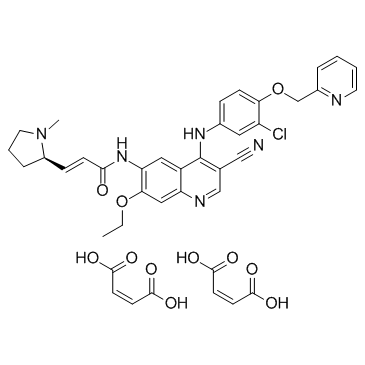Pyrotinib dimaleate
Modify Date: 2024-01-08 16:47:34

Pyrotinib dimaleate structure
|
Common Name | Pyrotinib dimaleate | ||
|---|---|---|---|---|
| CAS Number | 1397922-61-0 | Molecular Weight | 815.224 | |
| Density | N/A | Boiling Point | N/A | |
| Molecular Formula | C40H39ClN6O11 | Melting Point | N/A | |
| MSDS | N/A | Flash Point | N/A | |
Use of Pyrotinib dimaleatePyrotinib dimaleate (SHR-1258 dimaleate) is a potent and selective EGFR/HER2 dual inhibitor with IC50 s of 13 and 38 nM, respectively. |
| Name | Pyrotinib dimaleate |
|---|---|
| Synonym | More Synonyms |
| Description | Pyrotinib dimaleate (SHR-1258 dimaleate) is a potent and selective EGFR/HER2 dual inhibitor with IC50 s of 13 and 38 nM, respectively. |
|---|---|
| Related Catalog | |
| Target |
HER2:38 nM (IC50) EGFR:13 nM (IC50) |
| In Vitro | Pyrotinib dimaleate has high potency in HER2-dependent cell lines (BT474, SK-OV-3), while showing much weaker inhibition in the HER2 negative cell line (MDA-MB-231). Pyrotinib dimaleate inhibits BT474 and SK-OV-3 cells with IC50s of 5.1 and 43 nM, respectively. Pyrotinib dimaleate displays high selectivity as HKI-272 when tested in a panel of different kinases such as KDR, c-Kit, PDGFRβ, c-Src and C-Met (c-Src with an IC50 of 790 nM, and others >3000 nM)[1]. |
| In Vivo | Pyrotinib dimaleate has acceptable bioavailability of 20.6%, 43.5% and 13.5% in nude mice, rats and dogs, respectively. Pyrotinib dimaleate has favorable drug-like physicochemical properties and shows relatively higher oral exposure in human subjects (oral; t1/2=15 h) with a much longer half life than that of preclinical animal species such as mouse (i.v.; t1/2=1.56 h; i.g.; t1/2=2.52 h) and rat (i.v.; t1/2=4.42 h; i.g.; t1/2=3.38 h)[1]. |
| Cell Assay | Cancer cells (A431, SK-BR-3 and NCI-N87) are treated at a suitable concentration of Pyrotinib for 72 hours. Cell proliferation is determined by a sulforhodamine B (SRB) method. The IC50 values are calculated by the data of inhibition rates of serial concentrations of Pyrotinib dimaleate[1]. |
| Animal Admin | Rats[1] Sprague Dawley (SD) rats (200-250g, 3 males and 3 females) are used .Test compounds (include Pyrotinib dimaleate) are administrated in both intravenous ( i.v. ; 3 mg/kg) and intragastric ( i.g. ;3 mg/kg) for rats to obtain their bioavailability. Plasma samples of nude mice is collected at pre-dose and 0.083, 0.25, 0.5, 1, 2, 4, 6, 8, 12, 24 h after the IV administration [1]. Mice[1]: In vivo efficacy studies are performed on BALB/Ca-nude mice (6 to 7 weeks, female) from SLAC. Nude mice are hypodermic inoculated BT-474 human breast cancer cell or SK-OV-3 ovarian cancer cell. After tumor grows to 150-250 mm3, mice are randomly divided into groups and dosed with Pyrotinib (2.5, 5, 10, 20 mg/kg) once daily. The volume of tumors and the weight of the mice are measured and recorded for 2-3 times per weeks[1]. |
| References |
| Molecular Formula | C40H39ClN6O11 |
|---|---|
| Molecular Weight | 815.224 |
| Exact Mass | 814.236511 |
| Storage condition | 2-8℃ |
| 2-Propenamide, N-[4-[[3-chloro-4-(2-pyridinylmethoxy)phenyl]amino]-3-cyano-7-ethoxy-6-quinolinyl]-3-[(2R)-1-methyl-2-pyrrolidinyl]-, (2E)-, (2Z)-2-butenedioate (1:2) |
| (2E)-N-(4-{[3-Chloro-4-(2-pyridinylmethoxy)phenyl]amino}-3-cyano-7-ethoxy-6-quinolinyl)-3-[(2R)-1-methyl-2-pyrrolidinyl]acrylamide (2Z)-2-butenedioate (1:2) |
| SHR-1258 DIMALEATE |